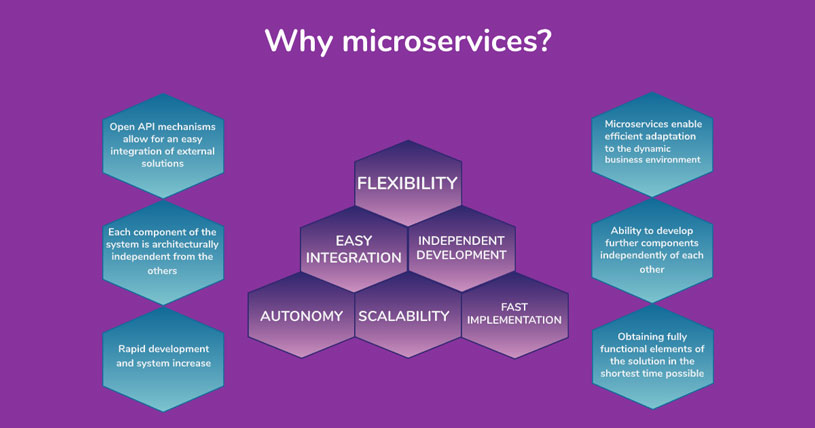6 MOST POPULAR PROGRAMMING LANGUAGES IN BANKING
If you asked a group of programmers what technology is best for banking software development, the answer would surely be "It depends." And it's hard to disagree with it, because the choice of technology depends on the goal it is to achieve. However, taking into account the specificity of the banking industry, stringent security standards and the need to comply with legislation, we have selected 7 technologies that are most often used in banking.
Cobol
Cobol is a kind of banking IT legend. Anyone who has had contact with this topic at least for a moment associates it as the long-standing foundation of all banking systems. Although nowadays programmers sometimes make fun of this language, it turns out to be wrong. According to Reuters data, as much as 43% of today's global IT banking systems are created using COBOL, so as you can see, it is still doing quite well. The name COBOL is an acronym for Common Business-Oriented Language and the fact that it works great in achieving business and commercial goals largely explains its use in banking. In addition, COBOL also has a simple and understandable syntax, which means that even a non-technical person can figure out a lot while reading the code.
C#
C # is a high-level object-oriented language developed by Microsoft. Despite the passage of years, it still ranks high in the popularity rankings of programming languages. It works great in creating complex systems and large projects, which in a way explains its place in this article. What distinguishes C # is primarily the fact that it is a technology from Microsoft's stable, which has at least two big advantages. The first is, of course, the fact that one of the technological giants is behind this language, with a huge budget for development and a lot of support. The second is undoubtedly great backward compatibility (a feature of the software, thanks to which - despite the change in functionality - the new version allows cooperation with the entire environment of the previous version and all its components). In the context of the desired predictability, Microsoft openly defines the direction of development of its technology, thanks to which the changes we will face over the next few years are clear and predictable.
C/C++
Although C / C ++ was created in the eighties of the last century, its wide range of applications means that many large systems and applications still rely on it. C ++ is distinguished by the fact that it works well for creating complex, multi-level systems due to the specific compiler. The C ++ compiler is type-compliant, so it is more difficult to make errors in code written in C ++, which leads us to greater security of applications written in C ++.
JAVA/ SPRING
Java is the undisputed queen of banking technology that needs no introduction. It is perfect for projects that require a very high level of security and high efficiency. In addition, it is characterized by high stability and is often used in large implementations. What distinguishes Java is its independence from architecture. The resulting code is independent of the operating system and processor, and is performed by the so-called Java virtual machine that (among other things) translates universal code into code adapted to the specifics of a specific operating system and processor. Such versatility means that wherever it is possible to install a virtual machine, it is also possible to use Java.
JAVASCRIPT/ ANGULAR.JS
JavaScript, or rather the framework of this language, Angular.js, is the most frequently chosen technology when creating the front-end layer of banking applications. JavaScript allows you to build web applications in the SPA - Single Page Application technology, which greatly facilitates the intuitive use of the application. As with other languages, Javascript is a very stable language that has been supported for many years. Considering the fact that front-end technologies change almost overnight and there is a large stratification among them, in the context of stability and predictability, JavaScript seems to be the most optimal choice.
PYTHON
Python is a technology that is most often used in the field of artificial intelligence and machine learning, as well as in data analysis and data science. It is a language of very wide application, and considering that banks are increasingly using AI algorithms, it is not surprising that Python is growing in popularity in this industry. Python is mathematically friendly, and therefore it "gets along" well with financial algorithms. Interestingly, many organizations in the area of fintech and core banking often use Python to analyze data, and taking into account the growing need for technological cooperation between the banking industry and other quasi-financial institutions, it can be expected that its popularity in this area will increase even more.
Summary
What is very significant in the case of banking technologies is the fact that long-supported and relatively predictable languages are usually chosen for the development of software and individual components. As banking systems are complex and extensive, banks rarely choose to rewrite them from one technology to another. Therefore, the key is stability and the guarantee that the language will be supported as long as possible, often at the expense of the technological development of the industry. One of the challenges for banking in the coming years will surely be finding a compromise between the use of proven solutions, security and stability, and the possibility of developing and using the latest technologies.
7 UNEXPECTED SOFT SKILLS, USEFUL FOR A PROGRAMMER'S WORK
In recent years, more and more has been said about soft skills in the context of IT, which is very pleasing because, for a long time, the area of emotional intelligence has been greatly underestimated in IT. Today, this approach is subject to considerable changes, and managers and heads of IT departments see the advantages of building technical teams, including soft skills. The specificity of IT shows how important communication skills and the ability to work effectively in a group are in the daily work of technical teams. However, there are competences that seem unnecessary in IT, but after deeper reflection, you can come to the conclusion that having them makes everyday work much easier. We chose 7, in our opinion, useful and non-obvious soft skills, which are very important in the context of working in IT:
Managing emotions
Managing emotions is a skill useful in general business, while playing a special role in the IT industry. Managing emotions, in the most general terms, comes down to interpreting, controlling and regulating one's own emotions in such a way that they do not interfere with action.
In psychology, the ability to perceive and interpret your own emotions is called insight. It is a necessary skill to work on self-control, not to react under the influence of strong agitation, and to adopt correct interpretations of various situations, not distorted by emotions. In an industry full of challenges, which is undoubtedly IT, there is no shortage of opportunities for tensions, frustration or anger, so it is even more important to control these situations so that they do not have too much influence on the work. A high level of emotional arousal has a negative impact on efficiency, focus and attention, and it is these processes that often determine the success of writing a complicated algorithm or analyzing critical errors in an application.
Flexibility
To put it simply, flexibility is the ability to adapt to a changing situation without incurring high emotional costs. Flexible people find it easier to cope with “the rules change during the game”, so this feature is extremely useful in a programmer's work. For those who have never been in a situation where the client changed the requirements or questioned previous arrangements when the project was already at an advanced stage, throw a stone first. Such situations in highly principled people evoke frustration and a lot of negative emotions, which most often affects work, while flexibility allows you to maintain the necessary peace, at the same time giving the opportunity to find an alternative when solving problems.
Creativity
After all, I am a programmer, I need no creativity, you will probably say. And well... at first glance, it's hard to deny this reasoning, but going deeper, you can see that creativity helps a lot in technical work. Being creative is strongly connected with the ability to solve problems, because people with this ability are able to see reality from a slightly wider perspective than the rest. They see relationships and relationships where they are apparently invisible, so they can find an unconventional solution when classic methods fail. Creative people are masters of workaround, often so necessary when you are faced with a big technological challenge.
Self-presentation
This is another soft skill that seems to be completely useless in the IT world. Presentations or speeches are rather the domain of marketing and sales departments, you will think. This belief is losing its relevance today, as it is more and more common for technical people to conduct internal workshops for younger programmers, take part in technical webinars, and prepare presentations for clients. In the era of social media and the trend of sharing their knowledge with recipients, technology companies make great use of the intellectual potential of their IT departments. Therefore, it is worth developing your self-presentation skills in order to feel more confident in such a situation and be able to focus only on the content of what is to be conveyed, without having to worry about the form.
Self-motivation
Technology companies are trying to outdo each other in creating incentive packages, bonus systems and benefits, which are not only to encourage people to work in a selected company, but also to maintain a high level of motivation. Such external motivators, which are not an inherent part of a given task, are, however, much less effective than internal motivation, understood as commitment to work resulting from the willingness to perform a specific action, even if there is no "external" reward associated with it. But intrinsic motivation also has its limitations. It happens that even when working in IT is your passion and you do it with pleasure, your desires weaken over time. A constantly dissatisfied client or supervisor who regularly adds responsibilities, projects to "tap", during which you do not learn new things - these are factors that negatively affect the level of internal motivation. So it's good when you can recognize this condition and deal with it effectively.
Resiliency
Resilience is simply mental resilience and the ability to adapt to unforeseen situations and to deal with problems. This ability is making a comeback recently, mainly due to the coronavirus pandemic. It can be said that the last few months have provided organizations, employers and employees with a huge resilience exam that we will remember for years. Mental resilience is a trait that can be successfully developed, which is very good news for people who need to work on it. Although the programmer's job seems to be very stable, it is not free from the unforeseen, both in technical and business terms. There are applications that, despite the best intentions, turn out to be unprofitable and unattractive for recipients, bugs that "come out" after the software release, or critical projects yesterday, generating a huge level of stress. Resilience and the ability to deal with such situations is essential for maintaining balance, and it also makes each subsequent problem not a dead end, but only a problem that you have to deal with and move on.
Time management
There are days when you work all day and in the evening you realize that you haven't actually done anything specific? The reason may be the inability to manage oneself in time, i.e. the lack of prioritization of tasks, a poor level of planning activities or time estimation, as well as the problem with setting goals. All this makes working under time pressure doubly stressful because you are worried not only about getting the job done right, but also about whether you will "make it". And in the IT industry, timeliness and efficiency, especially in working with clients, are very important, so it is worth focusing on this aspect of your work. Describing all the most effective techniques and methods of managing oneself in time would take too much space, but we recommend that you first get acquainted with the Eisenhower matrix and the Pomodoro technique, which will be great tools to support effective time management.
Although still underestimated, well-developed soft skills in the IT industry bring a number of advantages. It is this aspect of our daily work that helps to develop potential and increase efficiency, and this translates into better and better results at work, devoid of unnecessary frustration, fears or negative emotions.
From the point of view of the recruitment processes that we conduct at INCAT in order to carry out interesting tasks in the project, in the work of a programmer, not only programming skills are important to us. Technical knowledge and skills should go hand in hand with soft skills - their role is so important in the everyday tasks of a programmer, because projects are often diverse, require creative solutions, and provide technical information to people outside the industry. Regardless of the role of a programmer, whether he is a project manager or developer, he should be a communicative person. We pay a lot of attention to this skill as it is indispensable when planning a project as well as when making changes. Creating an application is not only lonely coding - it requires many months of team work and cooperation of many specialists, which is definitely helped by the implementation of the described skills in your professional everyday life. Definitely, all of them translate into work efficiency, and combined with specialist knowledge and experience, they will result in gaining a satisfying job and a sense of fulfillment - says Karolina Wolf, HR and recruitment specialist at INCAT.
Why is microservices architecture so effective? The answer is simple
Over the past few years, we can notice the growing popularity of microservice architecture, which is slowly pushing out the monolithic architecture that has dominated so far. Microservices, in contrast to monoliths, is a series of many, independent services and processes that create applications. Microservices are a convenient solution when creating an advanced system or large applications - it allows for quick project implementation and parallel work on several modules at the same time. Although such giants as Netflix or Uber based their solutions on microservices, this is not the only thing that makes this approach unique.

Flexibility
Microservices, in contrast to the architecture of monoliths, allow easy modification of functionality in the design. Since each microservice is an independent element of the application, its subsequent components can be changed, supplemented and removed in such a way that it does not affect the functioning of the whole. Therefore, problems such as cyclical change of automatic tests or the risk of stopping the entire application when implementing the next module are eliminated.
Easy integration
Open API, used in the microservice architecture, allows for quick and trouble-free integration with other services. A solution such as API Gateway mediates communication between modules, enabling the convenient adjustment of the API for specific clients, without the need to place it in every microservice.
Scalability
The modular approach allows you to react quickly and effectively to the dynamics of the business environment - changing business requirements does not mean restructuring the entire application, but only the module that relates to the given functionality. Furthermore, in the case of high loads, microservices allow for an efficient increase in the number of instances that balance redundant traffic in the application, which also addresses the problem of performance.
Quick implementation
Microservices provide the possibility of a quick MVP system release. With this architecture, it takes only a few weeks to implement a fully working, basic application that is ready for further development. On the other hand, the addition or modification of existing modules does not complicate the clients' ability to use the system in any way, because it is less invasive than the monolith architecture, and does not affect the core of the application.
Independent development and autonomy
The distributed architecture also means the independence of design teams. It does not have a central management center, thanks to which the flow of information is smoother. Each team works on "its" application element and does not have to consider the databases or architecture of the other modules. Interestingly, microservices allow you to develop each element in a different technology and language and maintain sites on separate servers and in repositories. Independence understood as such, solves the problem of technical debt and increases the efficiency of the system itself.
Of course, microservices are no medicine for all evil. At the moment, there is no architecture that is free of defects, and at the same time suitable for any type of application. It is no different with microservices. If you are considering implementing a microservice architecture, the key question you should ask yourself is not "Is?", but "How?"-this is because improper development of technical requirements and structure or lack of careful handling of traffic between servers, can ultimately do more harm than good. Neglecting these issues at the planning stage can cause a classic outpouring of a child with a bath, and as a result, it will most likely turn out that the architecture, which was supposed to facilitate many activities, actually spends all night sleeping. It is worth considering the support of a technical partner with experience in creating solutions based on microservices. Thanks to this, you will bypass many implementation difficulties and at the same time, be sure that you will have an efficient release and system that can be modified flexibly to adapt to rapidly changing business requirements.


